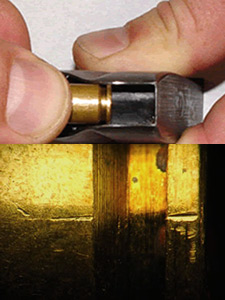Home | Glossary | Resources | Help | Contact Us | Course Map
Archival Notice
This is an archive page that is no longer being updated. It may contain outdated information and links may no longer function as originally intended.
Examination of Unfired Ammunition
Examinations of unfired ammunition, both unfired cartridges and shotshells, proceed in much the same way as for fired cartridge cases and shotshell cases. The obvious difference is the absence of chamber or breech face marks, and the possible presence of a light strike(s) from a firing pin. Identifications can still be made on extractor, ejector, and magazine marks. These marks are valid toolmark identifications. However, the significance of these unique associations is different.
Based on these microscopic marks, it may be possible to state that unfired ammunition was
- loaded into and extracted from a particular firearm,
- loaded into and removed from a magazine integral to or associated with a given firearm.
The reasons for the cycling of ammunition through the action of a firearm (without firing) may include
- a decision to remove a cartridge from the chamber as part of the normal unloading process,
- an effort to clear a misfire,
- an effort to clear a misfeed,
- a criminal unconsciously leaving courage marks by repeatedly cycling ammunition through the action prior to the commission of a crime,
- other reasons best known to a criminal prior to the seizure of a firearm by law enforcement.
Even if an unfired cartridge or shotshell does not bear any microscopic marks of value for comparison purposes, an examiner can at least determine the types of firearms for which it is intended or with which it is compatible.
Worksheets
Worksheets for unfired ammunition are similar to those for fired cartridge cases and shotshell cases, with the exception that
- any reference to chamber marks or breech face marks would be accompanied by a Not applicable entry on the worksheet,
- any reference to firing pin impressions would most often be accompanied by a None observed entry.
The same identification criteria apply to unfired ammunition as for any type of striated or impressed toolmark; conclusions are expressed in the same conventional fashion.
Additional Online Courses
- What Every First Responding Officer Should Know About DNA Evidence
- Collecting DNA Evidence at Property Crime Scenes
- DNA – A Prosecutor’s Practice Notebook
- Crime Scene and DNA Basics
- Laboratory Safety Programs
- DNA Amplification
- Population Genetics and Statistics
- Non-STR DNA Markers: SNPs, Y-STRs, LCN and mtDNA
- Firearms Examiner Training
- Forensic DNA Education for Law Enforcement Decisionmakers
- What Every Investigator and Evidence Technician Should Know About DNA Evidence
- Principles of Forensic DNA for Officers of the Court
- Law 101: Legal Guide for the Forensic Expert
- Laboratory Orientation and Testing of Body Fluids and Tissues
- DNA Extraction and Quantitation
- STR Data Analysis and Interpretation
- Communication Skills, Report Writing, and Courtroom Testimony
- Español for Law Enforcement
- Amplified DNA Product Separation for Forensic Analysts


